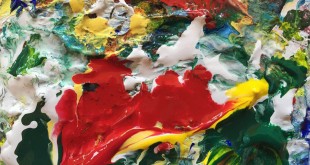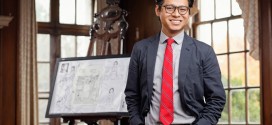By Amanda L. Andrei


Tonight, there is fog in Lorton, Virginia. The normally murky Route 123 is even more difficult to navigate—until you see bright lights emanating from the Lorton Workhouse Art Center. Inside, a welcoming gallery glow illuminates art lovers as they walk to artists’ opening receptions, admire new paintings and sculpture, and watch demonstrations of glassblowing and pottery making. It is Second Saturday Art Walk, a free community event held every second Saturday of the month. On this night, dozens of families and individuals experience the work of over 100 visual artists.
Hsi-Mei Yates is a Taiwanese painter skilled in calligraphy, watercolors, and sumi-e painting, also known as Chinese brush painting or ink wash painting. Standing at the front of a crowded room, with people squeezed between tables or sitting on the floor, she demonstrates proper techniques for painting bamboo in sumi-e style.
Sumi-e painting has been practiced for thousands of years, originating in China and eventually spreading to Korea and Japan to become known as a distinctly East Asian technique. By simplifying the artist’s tools to only four objects—ink stone, ink, brush, and paper (together known as the Four Treasures)—it seeks to capture the essence of a subject in a starkly beautiful image, focusing on shading, form, and space. Artists learn sumi-e brush painting by practicing “the Four Seasons,” named after the bamboo, chrysanthemum, plum blossom, and orchid plants that symbolize each season and employ a variety of brush strokes and values. Bamboo, for example, represents summer and gentle strength, bending with the wind but not breaking. To paint bamboo is to paint all the principles of Chinese composition in their simplest form, and the process is a challenge to master.
“I studied three years to get the bamboo right!” Yates explains with a laugh to the audience. “The teacher said, go home and paint this one thousand times, and I said, you gotta be kidding!” There is a twinkle in her eye. “But I did!”
Born and raised in and around Taipei, Taiwan, Yates was a talented young artist who won awards for artwork in school. In 1978, after graduation, she worked at China Pottery Art Company, a company noted for hand-painted ceramic products, refining her techniques and studying. In 1983, she moved to the United States and taught painting in Washington, D.C., Virginia, and North Carolina. Yates and her husband eventually settled in Stafford. She works out of her studio at Workhouse Art Center, and also teaches children and adults various East Asian painting techniques.
Yates’ Zodiac Series is displayed on the walls of the Studio 5 Gallery. Twelve animal signs are detailed in a gentle mix of sumi-e and watercolors. Beneath each painting is a smaller tile of calligraphy as tight and graceful as a well-choreographed dance. “Since my show was so close to Chinese New Year, I thought it would be interesting to paint the zodiac and allow people to learn a little bit about it,” Yates relates. “I took a lot of time to research each animal, sketch, and understand their life style to capture their essence for my collection.”
Chinese New Year on February 10 starts the Year of the Water Snake. Traditionally, the Year of the Snake follows the movement and rhythm of the Snake itself, moving elegantly and colorfully. This is also a year for beauty, style, and artistry. Fittingly, Yates says for the new lunar year, “I plan to create better art works and get some more good classes going. This show has been a good start!”
Yates puts final touches on a small branch of and begins drawing leaves. The room is full, with more onlookers standing outside with faces pressed to the glass, unable to hear her words but fascinated with the forms taking shape with black ink on rice paper. “Paper is very unforgiving—very absorbent,” Yates explains. “You have to inhale, hold your brush, and move your entire body. You have to have confidence in each stroke.”
In this way, painting is not so different from living. Once a stroke is committed to paper, an action committed in time, there is no going back. But there are opportunities to try again. As each movement is guided by breath and concentration, a beautiful and coherent picture may arise. As we welcome in the Year of the Snake, perhaps we can attune ourselves to this sense of grace, cleverness, and artistry as we inhale, hold our treasures, and move forward.
For information about Second Saturday Art Walk, visit http://workhousearts.org.
 Asian Fortune Your source for all things Asian American
Asian Fortune Your source for all things Asian American



